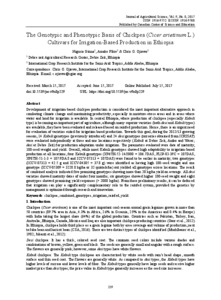The Genotypic and Phenotypic Basis of Chickpea (Cicer arietinum L.) Cultivars for Irrigation-Based Production in Ethiopia
Abstract
Development of irrigation-based chickpea production is considered the most important alternative approach in combating climate change and maximizing productivity, especially in moisture-stress areas and in areas where water and land for irrigation is available. In central Ethiopia, where production of chickpea (especially Kabuli type) is becoming an important part of agriculture, although many superior varieties (both desi and Kabuli types) are available, they have been evaluated and released based on rainfed production. Hence, there is an urgent need for evaluation of varieties suited for irrigation-based production. Towards this goal, during the 2012/13 growing season, 14 Kabuli genotypes (previously introduced) and 24 desi genotypes (nurseries obtained from ICRISAT) were evaluated independently at three and one locations respectively (Kabuli at Debre Zeit, Ambo and Werer; desi at Debre Zeit) for production adaptation under irrigation. The parameters evaluated were date of maturity, 100-seed weight and yield. Overall, while most Kabuli genotypes showed high adaptability to irrigation-based production at all locations, four Kabuli genotypes (X96TH-52-14/2000 = 106.7DAS, FLIP-02-39C = 107DAS, X98TH-51-1-3 = 107.9DAS and ICCV-07313 = 107DAS) were found to be earlier in maturity; two genotypes (ICCV-07313 = 42.5 g and ICCV-04305 = 37.8 g) were identified as having high 100-seed weight and one genotype (ICCV-05309 = 3228.8 kg/ha or 32 quintals/ha) out yielded all genotypes across locations. The result of combined analysis indicated five promising genotypes showing more than 20 kg/ha yield on average. All desi varieties showed maturity dates of under four months; six genotypes showed higher 100-seed weight and eight genotypes showed promising yield responses (> 2000 kg/ha). From these preliminary results, it can be deduced that irrigation can play a significantly complementary role to the rainfed system, provided the genetics by management is optimized through research and innovation

